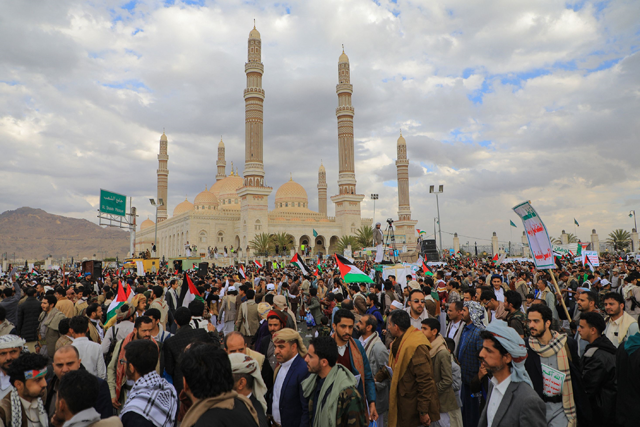You are here
US, UK strike dozens of Houthi targets in Yemen
By AFP - Feb 05,2024 - Last updated at Feb 05,2024

A handout photo released by the British ministry of defence on Saturday shows a RAF Typhoon FGR4 aircraft preparing to take off to conduct further strikes against targets in Yemen (AFP photo)
WASHINGTON — The United States and Britain struck dozens of targets in Yemen on Saturday in response to repeated attacks on shipping by Iran-backed Houthi rebels that have disrupted global trade and put lives at risk.
The joint air raids in Yemen come a day after a separate wave of unilateral American strikes against Iran-linked targets in Iraq and Syria that were carried out in response to the killing of three US soldiers in on January 28.
It is the third time that British and American forces have jointly targeted the Houthis and the United States has also carried out a series of air raids against them on its own, but the rebels' attacks have persisted.
Saturday's strikes hit "36 Houthi targets across 13 locations in Yemen in response to the Houthis' continued attacks against international and commercial shipping as well as naval vessels transiting the Red Sea", the United States, Britain and other countries that provided support for the operation said in a statement.
US Defence Secretary Lloyd Austin said the strikes "are intended to further disrupt and degrade the capabilities of the Iranian-backed Huthi militia to conduct their reckless and destabilising attacks",
"Coalition forces targeted 13 locations associated with the Houthis' deeply buried weapons storage facilities, missile systems and launchers, air defense systems, and radars," he said in a statement.
Neither Austin nor the joint statement identified the specific places that were hit, but the Houthis' Al Massirah television said Sanaa and other locations were targeted.
Meeting 'escalation with escalation'
Britain's defence ministry said Royal Air Force Typhoon warplanes struck targets including two ground control stations used to operate both attack and reconnaissance drones.
Sullivan said on Sunday he was unable to confirm whether the strikes had left any civilian casualties, but said the targets were “absolutely valid”.
Asked whether the United States would rule out the possibility of striking Iran directly, Sullivan told NBC, “Sitting here on television, it would not be wise for me to talk about what we’re ruling in and ruling out.”
“If [Iran] chose to respond directly to the United States, they would be met with a swift and forceful response from us,” he told ABC.
The Iran-backed Houthis began targeting Red Sea shipping in November, saying they were hitting Israel-linked vessels in support of Palestinians in Gaza, which has been ravaged by the Hamas-Israel war.
Separately, US Central Command (CENTCOM) said its forces carried out a strike against a Houthi anti-ship missile “prepared to launch against ships in the Red Sea” early Sunday morning after deeming it “presented an imminent threat” against military and commercial vessels in the area.
That strike came after CENTCOM said they had earlier Saturday also launched strikes against six other Houthi anti-ship missiles and that on Friday US forces had shot down eight drones in and near Yemen, and destroyed four more before they could be launched.
The Houthis began targeting Red Sea shipping in November, saying they were hitting Israel-linked vessels in support of Palestinians in Gaza, which has been ravaged by the Hamas-Israel war.
US and UK forces responded with strikes against the Houthis, who have since declared American and British interests to be legitimate targets as well.
Houthi spokesman Nasr Al Din Amer said following the Saturday strikes that “either there is peace for us, Palestine and Gaza, or there is no peace and no safety for you in our region”.
“We will meet the escalation with escalation,” he wrote on social media.
Strikes in Iraq, Syria
Anger over Israel’s devastating campaign in Gaza, which began after an unprecedented Hamas surprise attack on October 7, has grown across the Middle East, stoking violence involving Iran-backed groups in Lebanon, Iraq, Syria and Yemen.
Last weekend, a drone slammed into a base on a US base on Jordan’s north-eastern borders with Syria, killing three soldiers and wounding more than 40, an attack Washington blamed on Iran-backed forces.
US and allied troops have been attacked more than 165 times in Iraq, Syria and Jordan since mid-October, but the soldiers killed on January 28 were the first to die from hostile fire in the Middle East during that period.
The United States responded on Friday with strikes against dozens of targets at seven Tehran-linked facilities in Iraq and Syria, but did not hit Iranian territory.
Both the Iraqi and Syrian governments condemned the Friday strikes, while Tehran said they would “have no result other than intensifying tension and instability”.
Diplomatic sources meanwhile said the UN Security Council would convene Monday, after Russia called for a meeting “over the threat to peace and safety created by US strikes on Syria and Iraq”.
But British Foreign Secretary David Cameron has said Tehran is ultimately responsible for the violence, telling the Sunday Times in an interview that “we need to send the clearest possible signal to Iran that what they’re doing through their proxies is unacceptable”.
“You created them, you backed them, you financed them, you provided them with weapons and you will ultimately be held accountable for what they do,” Cameron said.
Related Articles
WASHINGTON — The United States will press on with its retaliation against Iran-backed groups in Iraq and Syria, White House National Securit
WASHINGTON — American and British forces carried out a fresh wave of strikes Saturday against 18 Houthi targets in Yemen, a joint statement
WASHINGTON — The US military said on Sunday it had struck more devices and missiles in Houthi-controlled areas of Yemen that were prepared t













